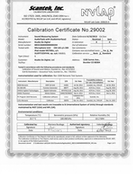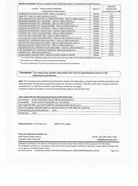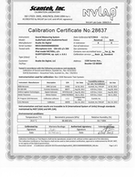Type 1 Certification
AudioTools 5.5 loaded onto an iPad 2, using an iAudioInterface2 as the audio input device with a Studio Six Digital CM-145 microphone has passed both ANSI S1.4-1983 and IEC 61672-3 Type 1 Sound Level Meter certification. The testing was done by Scantek Labs, Inc.
Here are the ANSI scans of the test results for the testing of the system that we sent in:
And here are the IEC test results for the same system:
Here are the CM-145 microphone results for the mic that was submitted:
This certification was done on a single system, however we believe that another similar system sent in for testing with a suitable microphone will also pass.
Microphone Type — What makes a Type 1 Mic?
In truth, there is no such thing as a Type 1 (or Class 1) microphone, only a Type 1 Sound Level Meter. According to both the US ANSI S1.43 specification, and the European counterpart, IEC 804, the entire system must be tested against the specification as a single unit.
In our case, that would include an iOS device running our AudioTools app, connected to one of hardware interfaces. It would be possible to have the entire system type-certified, at a testing lab. We work with West Caldwell Labs in New York, and they are fully setup to certify a system including iPrecisionMic and your iOS device.
See this page for more information about certifying iPrecisionMic.
AudioTools Standards Compliance
In our case, all of the algorithms, filters, and features of the SPL Meters and have been written to meet or exceed the standard for Type. And, in the case of the RTA, the filters are written to meet Class 1 of ANSI S1.11. So, if you use our software with a microphone that meets Type 1 or Type 2 specs you will in theory have a meter that meets these specs.
To be fully compliant, you would have to submit your microphone and iAudioInterface2 for calibration, to a designated calibration facility, and have a mic that meets all of the Type 1 specifications, which are summarized below.
Type 1 Standards Summary
Here is a summary (not intended to replace the specs) of some of the main features that a mic would have to meet, to be useful as the microphone in a Type 1 Sound Level Meter:
Frequency Response
This is probably what most people think about first.
- 20 Hz, +/- 2.5dB
- 25 Hz, +/- 2.0dB
- 31.5 and 40 Hz, +/- 1.5 dB
- 50 through 4000 Hz, +/- 1.0 dB
- 5000 Hz, +/- 1.5 dB
- 6300 Hz, +1.5, -2.0dB
- 8000 Hz, +1.5, -3.0 dB
- 10000 Hz, +2.0, -4.0 dB
- 12500 Hz, +3.0, -6.0 dB
- 16000 Hz, +3.0, -infinity (therefore not required)
- 20000 Hz, +3.0, -infinity “
That was the easy one, now for the more challenging ones to meet.
Linear Operating Range
Generally, 60 dB of operating range, with +/- 0.7 dB variability.
Free-Field vs Random Incidence
This is difficult to summarize, but there are strict limits (approx. +/-2.5 dB at 22 degrees) on how omnidirectional the microphone is, in actual use.
Environmental
In most cases, a plastic diaphragm mic cannot meet these specs.
Atmospheric pressure, no more than 0.3 dB change for a +/- 10% change in pressure.
Air temperature, no more than +/- 0.5dB change between 10 and 50 degrees C — or 50 to 122 degrees F.
Humidity, no more than 0.5 dB change from 30% to 90% humidity at 40 degrees C (104 degrees F).








